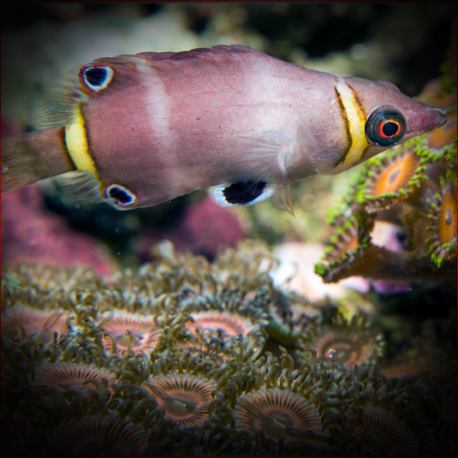More info
Datasheet
| Minimum Tank Size | 50 litres / 13.21 US gallons |
| Maximum Size | 8.0cm / 3.15inches |
| Reef Compatible | Always reef safe |
| Temperament | Docile |
| Temperature | 22.2°C / 71.96°F - 25.6°C / 78.08°F |
| Specific Gravity | 1.020-1.025 |
| Carbonate Hardness | 8-12 |
| pH | 8.1-8.4 |
General Description
The Sharpnose wrasse, scientifically known as Wetmorella nigropinnata, is a species belonging to the Labridae family. These wrasses are small in size, typically reaching a maximum length of 8.0cm. They are commonly referred to as Yellow-banded possum wrasse, Blackspot pigmy wrasse, Black-spot pigmy wrasse, or Possum wrasse.
Aquarium Suitability
These wrasses are well-suited for nano aquaria due to their small size. They are peaceful in nature and feed on invertebrates, requiring multiple feedings throughout the day if natural food sources are scarce. It is advisable to house them in tanks larger than 50 liters, especially considering their shyness and tendency to hide among rocks. They should not be kept with aggressive tank mates but can be housed together if introduced simultaneously.
Care and Hardiness
The Sharpnose wrasse is considered hardy, making it relatively easy to care for in a well-established aquarium. They are docile and shy, hence caution is necessary when selecting tank mates. These fish are sensitive during transportation and acclimatization, emphasizing the need for a peaceful environment around the tank for optimal visibility.
Reef Suitability
Sharpnose wrasses are always deemed reef safe, making them an excellent addition to reef aquarium setups. They assist in controlling unwanted invertebrates like flatworms and pyramid snails, contributing positively to the reef ecosystem.
Aquarium Setup
When setting up an aquarium for Sharpnose wrasses, it is essential to provide plenty of live rocks for hiding spots. Maintaining water conditions with pH levels between 8.1-8.4, a temperature range of 22.2-25.6°C, and a specific gravity of 1.020-1.025 is crucial for their well-being. Additionally, ensuring a well-established tank with an abundance of micro-life such as copepods and amphipods is beneficial as they can forage for food.
Behaviour
These wrasses are known for their docile temperament and tendency to spend time hiding amongst rocks. They are most active during the day and should be kept in a peaceful environment to encourage visibility.
Feeding and Diet
The Sharpnose wrasse requires a varied diet consisting of small crustaceans like krill and mysis, as well as zooplankton such as cyclops and pods. Feeding several times a day, especially during initial acclimatization, is recommended for their health and well-being.
Dimorphism
Sharpnose wrasses are hermaphroditic, with the ability to change gender from female to male as needed. This natural phenomenon occurs to ensure the presence of the appropriate reproductive roles within a group of these wrasses.

